
Here you can study for the exam. Look up keywords and learn definitions about all kind of subjects.
An automotive battery is a rechargeable battery that supplies electrical current to a motor vehicle. Its main purpose is to feed the starter, which starts the engine. Once the engine is running, power for the car's electrical systems is still supplied by the battery with the alternator charging as demands increase or decrease.
Brake fluid is a type of hydraulic fluid used in hydraulic brake and hydraulic clutch applications in automobiles, motorcycles, light trucks, and some bicycles. It is used to transfer force into pressure, and to amplify braking force. It works because liquids are not appreciably compressible.
Only the brakes can stop your vehicle. It is very dangerous if the brakes do not work properly. If the brakes make a lot of noise, give off a weird odor, or if the brake pedal does not work properly, have it checked with your garage. A vehicle that is pulled to one side when braking is also checked.
A cargo or freight refer in particular to goods or produce being conveyed, generally for commercial gain. Cargo covers all types of freight, including that carried by rail, van, truck, or intermodal container. The term freight is commonly used to describe the movements of flows of goods being transported by any mode of transportation.
A coolant is a substance, typically liquid or gas, that is used to reduce or regulate the temperature of a system. An ideal coolant has high thermal capacity, low viscosity, is low-cost, non-toxic, chemically inert and neither causes nor promotes corrosion of the cooling system. Some applications also require the coolant to be an electrical insulator.
 © Wikimedia.org/Gasper12345, CC BY-SA
© Wikimedia.org/Gasper12345, CC BY-SA
A dashboard is a control panel usually located directly ahead of a vehicle's driver, displaying instrumentation and controls for the vehicle's operation.
A badly running engine may fail while you are driving, this can cause serious problems for you and other road users. A poorly maintained engine is difficult to start, polluting, and uses more fuel.
The engine oil ensures smooth engine operation and prevents overheating. There must always be sufficient engine oil in the engine. So make sure you know where the dipstick is and regularly check the oil level. You have to do that when the engine is cold (or stopped for a while) and the car is horizontal.
The exhaust system reduces the noise coming from the engine and helps cool the exhaust fumes from the engine. It transports the gases to the rear of the vehicle. Gasses that are released from a leaking exhaust system can be deadly in a short time. Never run an engine in a closed garage or small space.
The fuel economy of an automobile relates distance traveled by a vehicle and the amount of fuel consumed. Consumption can be expressed in terms of volume of fuel to travel a distance, or the distance travelled per unit volume of fuel consumed. Since fuel consumption of vehicles is a significant factor in air pollution, and since importation of motor fuel can be a large part of a nation's foreign trade, many countries impose requirements for fuel economy. Different methods are used to approximate the actual performance of the vehicle.
A fuel gauge or gas gauge is an instrument used to indicate the amount of fuel in a fuel tank. As used in vehicles, the gauge consists of two parts: The sending unit - in the tank and the indicator on the dashboard.
A glove compartment or glovebox or glovie is a compartment built into the dashboard of an automobile, located over the front-seat passenger's footwell, and often used for miscellaneous storage. The name derives from the original purpose of the compartment, to store driving gloves.
A handbrake or parking brake is a mechanism used to keep the vehicle securely motionless when parked. Historically, it was also used to help perform an emergency stop should the main hydraulic brakes fail. Parking brakes often consist of a cable connected to two wheel brakes, which is then connected to a pulling mechanism. In most vehicles, the parking brake operates only on the rear wheels, which have reduced traction while braking. The mechanism may be a hand-operated lever, a straight pull handle located near the steering column or a foot-operated pedal located with the other pedals.
A jack is an object to lift heavy things with. A common use is to lift a car slightly to replace a wheel.
A car key or an automobile key is a key used to open and/or start an automobile. Modern key designs are usually symmetrical, and some use grooves on both sides, rather than a cut edge, to actuate the lock. It has multiple uses for the automobile with which it was sold. A car key can open the doors, as well as start the ignition, open the glove compartment and also open the trunk (boot) of the car.
A roof rack is a set of bars secured to the roof of a car. It is used to carry bulky items such as luggage, bicycles, canoes, kayaks, skis, or various carriers and containers. They allow users of an automobile to transport objects on the roof of the vehicle without reducing interior space for occupants, or the cargo area volume limits such as in the typical car's trunk design. These include car top weatherproof containers, some designed for specific cargo such as skis or luggage.
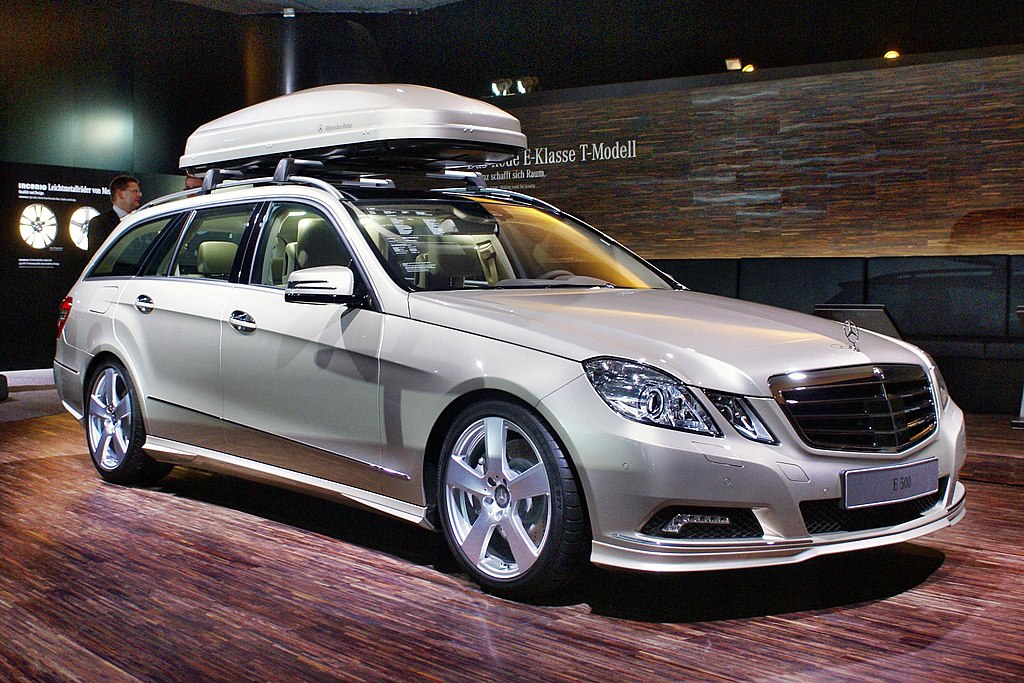 © Wikimedia.org/Matti Blume, CC BY-SA
© Wikimedia.org/Matti Blume, CC BY-SA
Snow chains are devices fitted to the tires of vehicles to provide maximum traction when driving through snow and ice. Snow chains attach to the drive wheels of a vehicle or special systems deploy chains which swing under the tires automatically. Although named after steel chain, snow chains may be made of other materials and in a variety of patterns and strengths. Chains are usually sold in pairs and often must be purchased to match a particular tire size.
A spare tire (also called spare wheel) is an additional wheel with a tire for a motor vehicle. It is intended as a replacement for a car tire when it is leaked along the way.
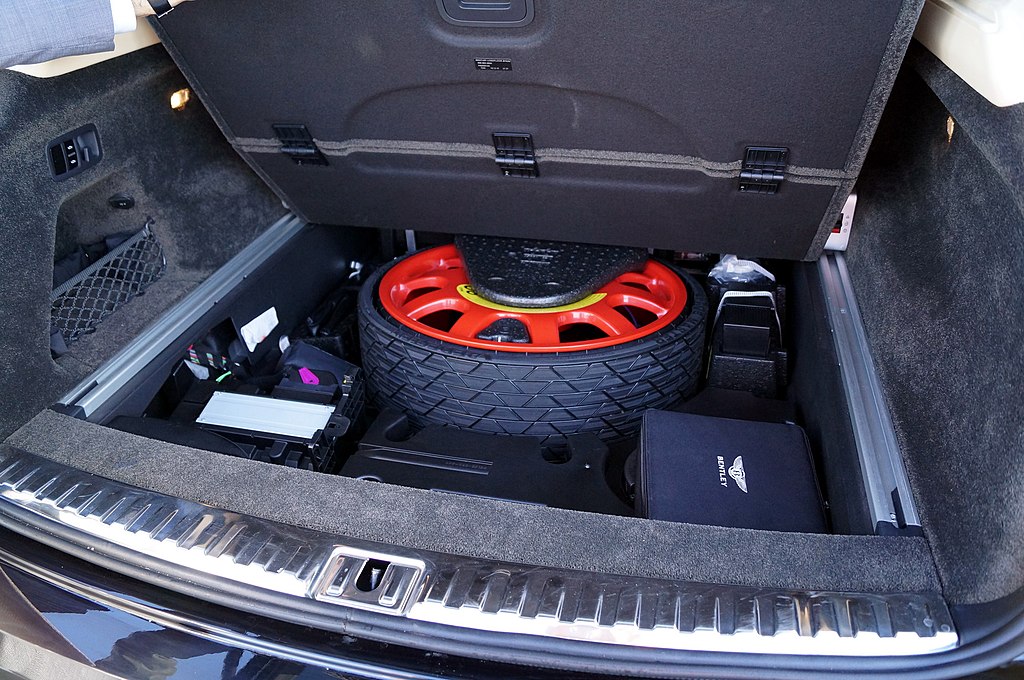 © Wikimedia.org/Mike-fiesta, CC BY-SA
© Wikimedia.org/Mike-fiesta, CC BY-SA
The suspension is the system of tires, tire pressure, springs, shock absorbers and couplings that connects the vehicle to the tires. The wheel suspension helps to have a good control over the vehicle and ensures a comfortable ride over different types of road surfaces.
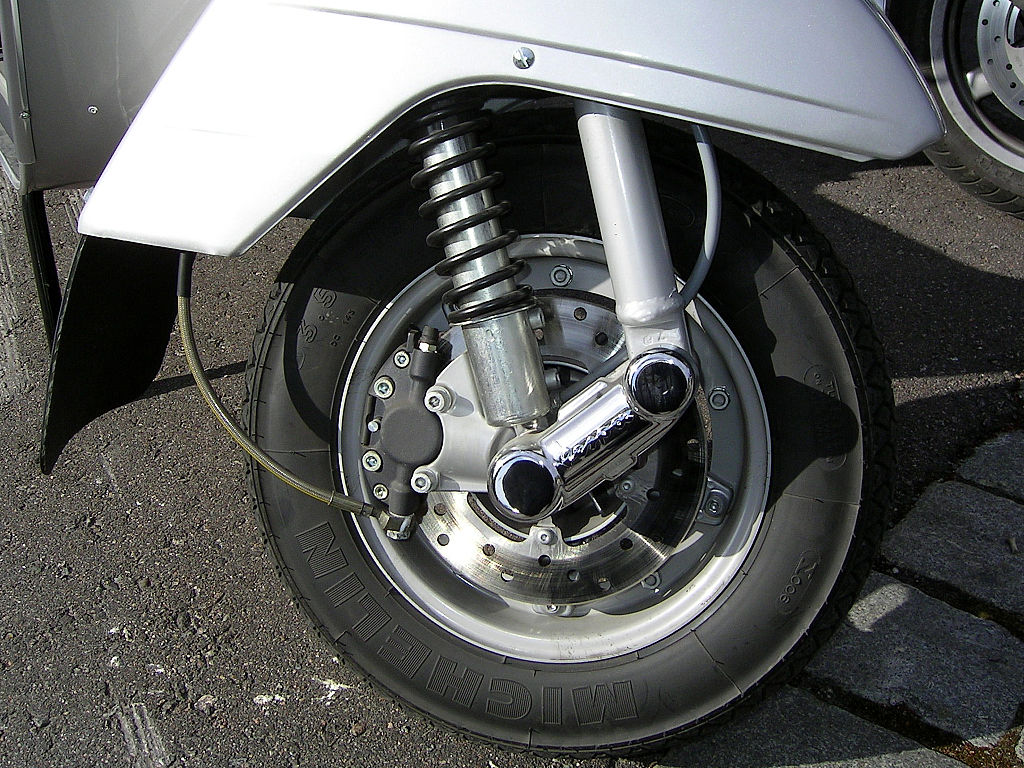 © Wikimedia.org/Khaosaming, CC BY-SA
© Wikimedia.org/Khaosaming, CC BY-SA
A tachometer is an instrument measuring the rotation speed of a shaft or disk, as in a motor or other machine. The device usually displays the revolutions per minute (RPM) on a calibrated analogue dial, but digital displays are increasingly common.
Automobile tires are described by an alphanumeric tire code, which is generally molded into the sidewall of the tire. This code specifies the dimensions of the tire, and some of its key limitations, such as load-bearing ability, and maximum speed. Sometimes the inner sidewall contains information not included on the outer sidewall, and vice versa.
The tire pressure must be measured when the tires are cold. Consult the vehicle manual for the correct tire pressure. Most tires have wear indicators that indicate when the tire needs to be replaced.
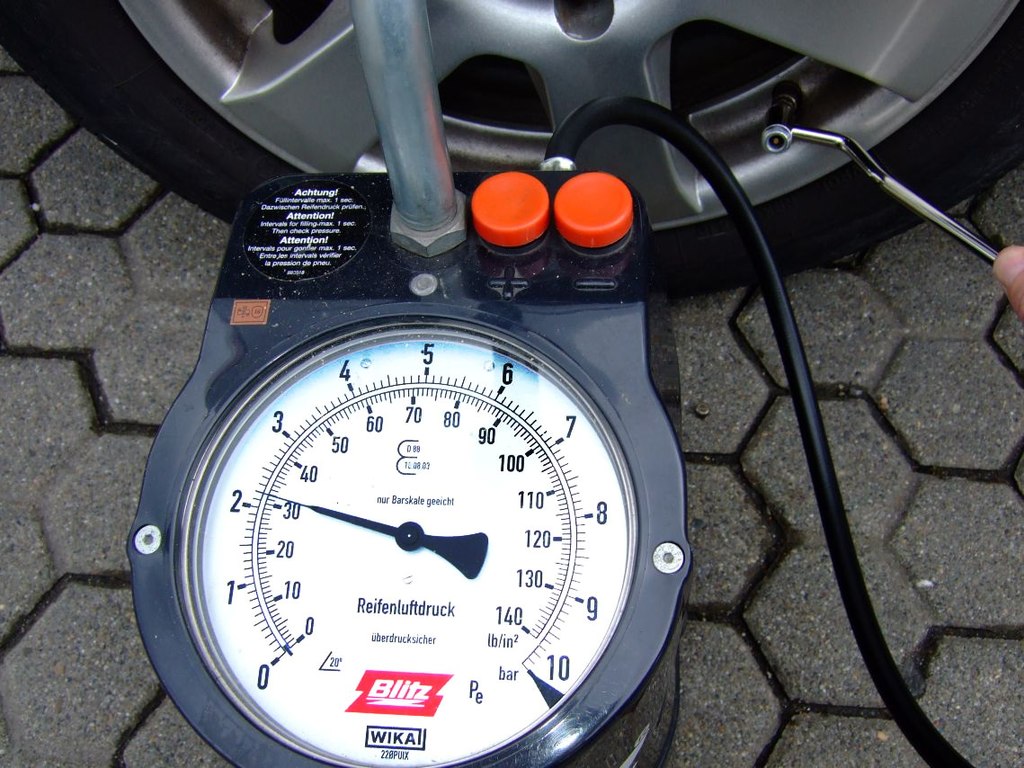 © Wikimedia.org/JEG14, CC0
© Wikimedia.org/JEG14, CC0
Worn or bald tires can increase your stopping distance and make turning more difficult when the road is wet. Unbalanced tires and low-pressure cause faster tire wear, reduce fuel economy, and make the vehicle harder to steer and stop. If the vehicle bounces, the steering wheel shakes, or the vehicle pulls to one side, have a mechanic check it. Worn tires increase the effect of “hydroplaning” and increase the chance of having a flat tire.
A trunk of a car is the vehicle's main storage or cargo compartment. The trunk or luggage compartment is most often located at the rear of the vehicle. Early designs included an exterior rack mounted on the rear of the vehicle to which it was possible to attach a real luggage trunk. Later designs integrated the storage area into the vehicle's body and evolved to provide a streamlined appearance. The main storage compartment is normally provided at the end of the vehicle opposite to which the engine is located.
A vehicle is any means of transport on land, as well as all mobile agricultural or commercial equipment.
A horn is a sound-making device that can be equipped to motor vehicles, buses, bicycles, trains, trams and other types of vehicles. The sound made usually resembles a 'honk' or a 'beep'. The driver uses the horn to warn others of the vehicle's approach or presence, or to call attention to some hazard.
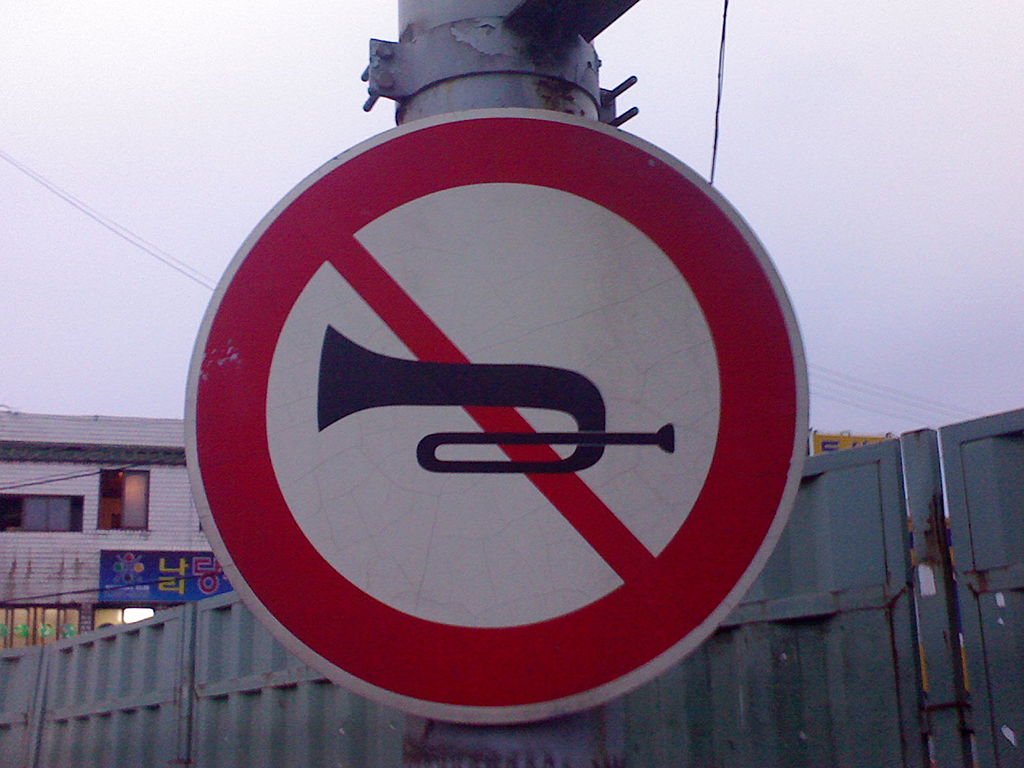 © Wikimedia.org/P.Ctnt, CC0
© Wikimedia.org/P.Ctnt, CC0
A windscreen wiper is a device used to remove rain, snow, ice, washer fluid, water, and/or debris from a vehicle's front window so the vehicle's operator can better see what's ahead of them. Almost all motor vehicles, including cars, trucks, buses and trains are equipped with one or more such wipers, which are usually a legal requirement.
It is important that you are able to see clearly through the windows and windshield. Clear snow, ice, or frost from all windows before driving. Make sure the inside of the windshield and windows are clean as well. Damaged glass can break very easily in a minor collision or when something hits the windshield. Have a damaged windshield replaced. Windshield wipers keep the rain and snow off the windshield. Some vehicles also have wipers for rear windows. Make sure all wipers are in good operating condition. If the blades are not clearing water well, replace them.
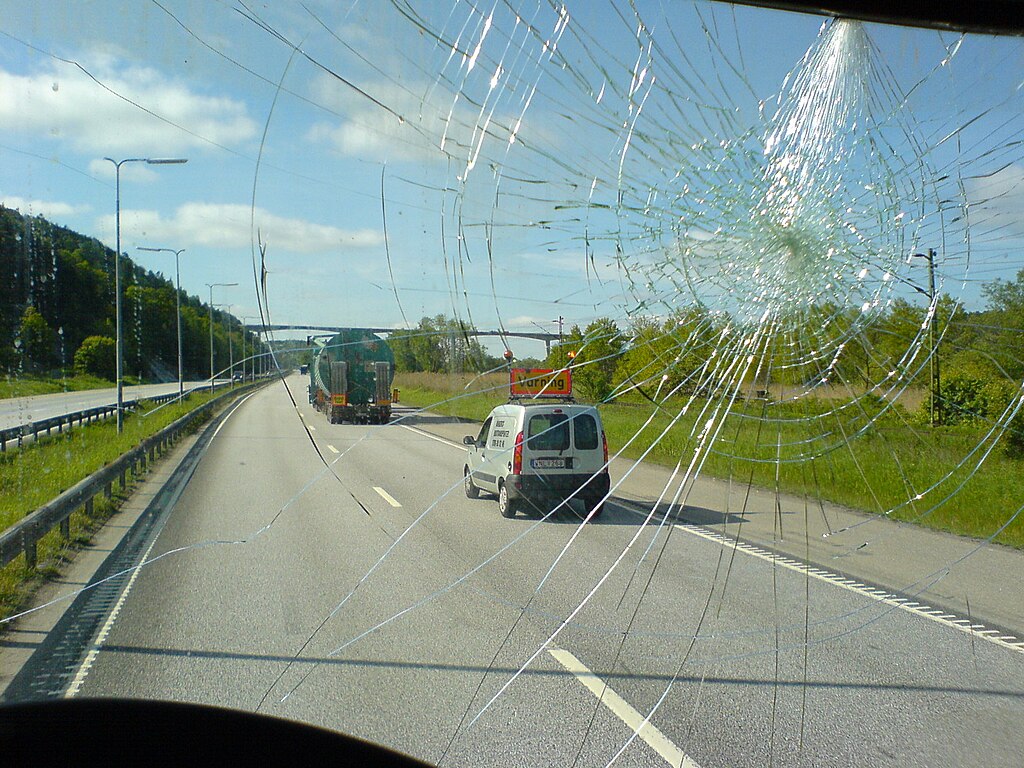 © Wikimedia.org/Vcx, CC BY-SA
© Wikimedia.org/Vcx, CC BY-SA
Winter tires or snow tires are designed for use on snow and ice. Winter tires have a tread design with larger gaps than those on summer tires, increasing traction on snow and ice. Such tires that have passed a specific winter traction performance test are entitled to display a 'Snow Flake' symbol on their sidewalls. Tires designed for winter conditions are optimized to drive at temperatures below 7 °C (45 °F). Some winter tires have metal or ceramic studs that protrude from the tire to increase traction on hard-packed snow or ice. Studs abrade dry pavement, causing dust and creating wear in the wheel path. Regulations that require the use of winter tires or permit the use of studs vary by country.
 © Wikimedia.org/A7N8X, CC BY-SA
© Wikimedia.org/A7N8X, CC BY-SA

Help us promote traffic rules on the internet, together we can make the public road safer for everyone. Post a comment or share on social media!
look at the sign on the road to avoid accidents and horrible driving conditions
I received a 300$ ticket because I passed a police control of other cars/drivers on the right lane of a highway (the control was on the hard shoulder of the highway). Is it really true, that you have to change the lane in such cases? Thanks!
I am an American living in Italy. The Italian Drivers License theory test is the hardest test I have ever studied for and I am in my 70s have multiple degrees, multiple professional certifications. Have to take the Italian Drivers Theory test in Italian. No english. So many rules. More signs in small medieval Italian town I live in then in major US cities I have lived in. No Italian license no driving. No buying or renting a car. Test here was good, clean. Lots of tricky questions on many practice and real official tests. Thanks
Most problems are a result of higher than safe driving speeds. Please just slow down and be patient.
Question 121: Poor translation: Vehicles with polluted fluids prohibited Should be translated as: Vehicles with dangerous liquids prohibited
Question 83: Poor translation: Vehicles with polluted fluids prohibited Should be translated as: Vehicles with dangerous liquids prohibited
Want even more practice? Visit similar websites offering realistic practice driving knowledge tests. Visit us to see what sets our tests apart! https://dkttest.com/capital-territory/
Cool tool! And fun to check whether I remember the rules :) Two things I noticed: Warning for a crossroad side roads on the left and right. While technically that might be the correct translation, this sign tells you, that you are on the main road and have the right of way for the next crossroad and only the next crossroad. Usually (if no sign specifies otherwise) you have to give way to drivers coming from the right at every intersection, which can get a bit annoying in communal areas, so seeing this sign feels less like a warning and more like relief :). A Fahrradstraße is not a lane for cyclists but a street for cyclists, meaning the (whole!) street is intended predominantly for cyclists, who are then allowed to ride next to each other. Cars are allowed to drive there (unless another sign prohibits such), but have to adjust their speed to the cyclists. I believe they are not allowed to pass at all, even if the oncoming lane is empty.
More community